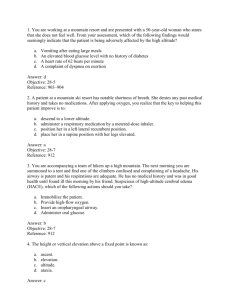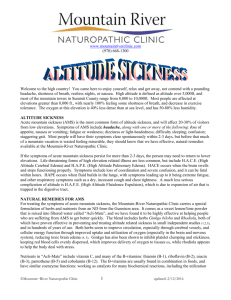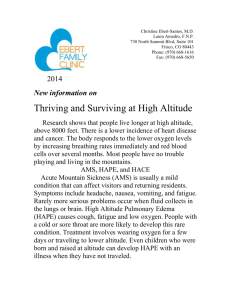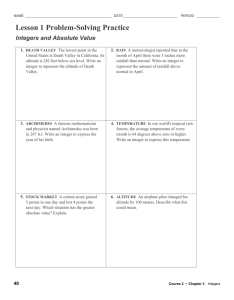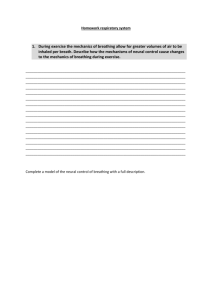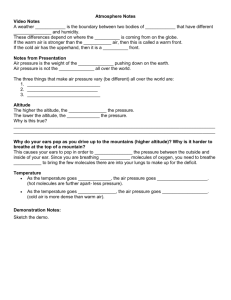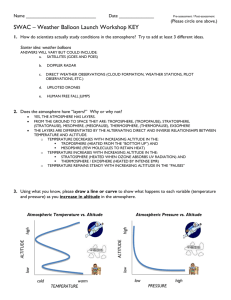Everest Article - The Biology Corner
advertisement
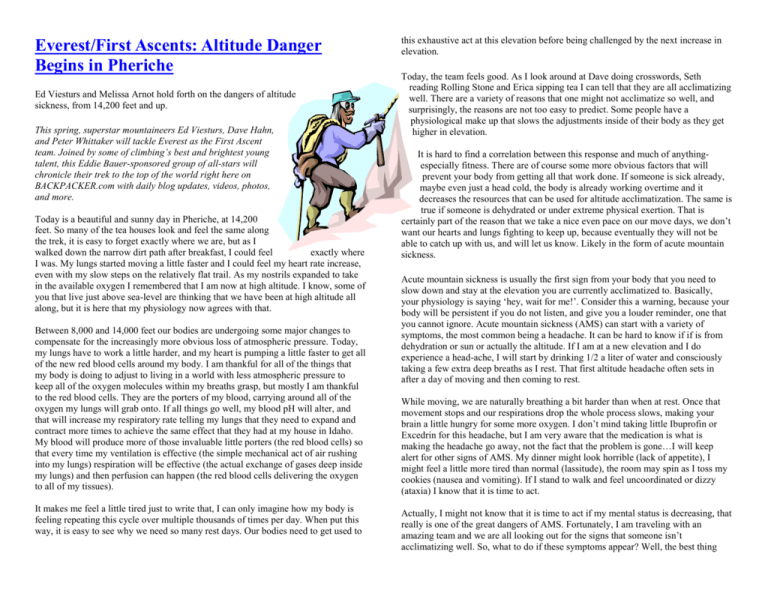
Everest/First Ascents: Altitude Danger Begins in Pheriche Ed Viesturs and Melissa Arnot hold forth on the dangers of altitude sickness, from 14,200 feet and up. This spring, superstar mountaineers Ed Viesturs, Dave Hahn, and Peter Whittaker will tackle Everest as the First Ascent team. Joined by some of climbing’s best and brightest young talent, this Eddie Bauer-sponsored group of all-stars will chronicle their trek to the top of the world right here on BACKPACKER.com with daily blog updates, videos, photos, and more. Today is a beautiful and sunny day in Pheriche, at 14,200 feet. So many of the tea houses look and feel the same along the trek, it is easy to forget exactly where we are, but as I walked down the narrow dirt path after breakfast, I could feel exactly where I was. My lungs started moving a little faster and I could feel my heart rate increase, even with my slow steps on the relatively flat trail. As my nostrils expanded to take in the available oxygen I remembered that I am now at high altitude. I know, some of you that live just above sea-level are thinking that we have been at high altitude all along, but it is here that my physiology now agrees with that. Between 8,000 and 14,000 feet our bodies are undergoing some major changes to compensate for the increasingly more obvious loss of atmospheric pressure. Today, my lungs have to work a little harder, and my heart is pumping a little faster to get all of the new red blood cells around my body. I am thankful for all of the things that my body is doing to adjust to living in a world with less atmospheric pressure to keep all of the oxygen molecules within my breaths grasp, but mostly I am thankful to the red blood cells. They are the porters of my blood, carrying around all of the oxygen my lungs will grab onto. If all things go well, my blood pH will alter, and that will increase my respiratory rate telling my lungs that they need to expand and contract more times to achieve the same effect that they had at my house in Idaho. My blood will produce more of those invaluable little porters (the red blood cells) so that every time my ventilation is effective (the simple mechanical act of air rushing into my lungs) respiration will be effective (the actual exchange of gases deep inside my lungs) and then perfusion can happen (the red blood cells delivering the oxygen to all of my tissues). It makes me feel a little tired just to write that, I can only imagine how my body is feeling repeating this cycle over multiple thousands of times per day. When put this way, it is easy to see why we need so many rest days. Our bodies need to get used to this exhaustive act at this elevation before being challenged by the next increase in elevation. Today, the team feels good. As I look around at Dave doing crosswords, Seth reading Rolling Stone and Erica sipping tea I can tell that they are all acclimatizing well. There are a variety of reasons that one might not acclimatize so well, and surprisingly, the reasons are not too easy to predict. Some people have a physiological make up that slows the adjustments inside of their body as they get higher in elevation. It is hard to find a correlation between this response and much of anythingespecially fitness. There are of course some more obvious factors that will prevent your body from getting all that work done. If someone is sick already, maybe even just a head cold, the body is already working overtime and it decreases the resources that can be used for altitude acclimatization. The same is true if someone is dehydrated or under extreme physical exertion. That is certainly part of the reason that we take a nice even pace on our move days, we don’t want our hearts and lungs fighting to keep up, because eventually they will not be able to catch up with us, and will let us know. Likely in the form of acute mountain sickness. Acute mountain sickness is usually the first sign from your body that you need to slow down and stay at the elevation you are currently acclimatized to. Basically, your physiology is saying ‘hey, wait for me!’. Consider this a warning, because your body will be persistent if you do not listen, and give you a louder reminder, one that you cannot ignore. Acute mountain sickness (AMS) can start with a variety of symptoms, the most common being a headache. It can be hard to know if if is from dehydration or sun or actually the altitude. If I am at a new elevation and I do experience a head-ache, I will start by drinking 1/2 a liter of water and consciously taking a few extra deep breaths as I rest. That first altitude headache often sets in after a day of moving and then coming to rest. While moving, we are naturally breathing a bit harder than when at rest. Once that movement stops and our respirations drop the whole process slows, making your brain a little hungry for some more oxygen. I don’t mind taking little Ibuprofin or Excedrin for this headache, but I am very aware that the medication is what is making the headache go away, not the fact that the problem is gone…I will keep alert for other signs of AMS. My dinner might look horrible (lack of appetite), I might feel a little more tired than normal (lassitude), the room may spin as I toss my cookies (nausea and vomiting). If I stand to walk and feel uncoordinated or dizzy (ataxia) I know that it is time to act. Actually, I might not know that it is time to act if my mental status is decreasing, that really is one of the great dangers of AMS. Fortunately, I am traveling with an amazing team and we are all looking out for the signs that someone isn’t acclimatizing well. So, what to do if these symptoms appear? Well, the best thing would be to descend 2000-3000 feet. As you go down in elevation, the positive effects are almost instant. At just a few thousand feel lower, I can start to feel better. The key now is to rest at this elevation and let my body catch up before going higher again. It also helps to hike a few thousand feet during the day, but sleep at the same altitude for a few nights. That gives my body a chance to taste a higher altitude while still recovering at a lower one (you will notice this once we embark on our climbing schedule at ‘extreme altitude’). QUESTIONS: 1. a. b. c. d. How does the body adjust to a higher altitude? respiration rate increases heart rate increase blood pH alters all of these High altitude illness will not likely go away without some action from you (descend)! Conversely, it often progresses and gets worse. You can get swelling and fluid accumulation in your brain that will cause further changes in your level of consciousness, possibly even causing you to go unconscious or stop breathing. That is called cerebral edema, a brain injury caused by increased intracranial pressure secondary to swelling in the brain. It can even look a lot like a stroke or traumatic brain injury, just with a different cause. This is a serious and life threatening emergency, and this person needs descent (which can be complicated if they aren’t conscious), oxygen and steroids to decrease the swelling in the brain. Bad news bears. 2. a. b. c. d. What is perfusion? the delivery of oxygen to the tissues an increase in heart rate tiredness due to lack of oxygen a severe headache The other life threatening altitude emergency is pulmonary edema, which is fluid build up in the lungs. As the pressure outside decreases, the pressure inside of our pulmonary vessels increases and sometimes the leak into the spaces in our lungs that are vital for gas exchange. This is basically a pneumonia and will cause difficulty breathing, and difficulty absorbing the oxygen (which could precipitate cerebral edema). This is another one where we need immediate descent and oxygen as well as some medications that can reduce the causes of the fluid build up. Here in Pheriche there is a medical clinic staffed and run by the Himalayan Rescue Association. There are western trained doctors working there (often volunteering time away from their own medical practices). This clinic is open to climbers, trekkers and porters. They do an altitude talk each afternoon and they do an amazing job educating people on the above mentioned dangers and the importance of listening to your body and being conservative. As a medical professional, I am thankful that the clinic is here. So many people feel sick and assume they just needed to do more training when realistically, their bodies aren’t adjusting to the altitude. The clinic helps to educate people and reduce the trepidation about descending if you aren’t feeling well. Our group is experienced, yet that doesn’t guarantee that we are safe from altitude illness. What is does do is ensure that we are paying attention, and we have created a schedule that will allow our bodies to physiologically adjust to the rigors we are presenting. So today, as I watch Dave complete crosswords with impressive speed, Seth is reading Rolling Stone and Erica excitedly orders and eats her second helping of food for the day, I can say we are looking pretty good physiologically, and it is a beautiful day at 14,200 feet in Pheriche. —Melissa Arnot 3. The first sign of acute mountain sickness is: a. nausea b. lassitude c. headache d. lack of appetite 4. a. b. c. d. The main point of the article is to: describe the scenery as hikers travel to the top of the mountain describe the physiological changes the body undergoes at high altitudes warn climbers about the dangers of acute mountain sickness describe the anatomy of the heart and lungs in relation to elevation 5. What is one way to avoid getting mountain sickness? a. drink lots of fluids b. ascend slowly c. breathe faster d. eat food high in carbohydrates 6. a. b. c. d. How does a person cure mountain sickness? descend to a lower altitude take aspirin spend time in a hyperbaric chamber to repressurize the lungs do aerobic exercises 7. a. b. c. d. Pulmonary edema occurs when: marrow does not produce enough red blood cells tissues of the body become starved of oxygen pH levels of the blood rise to dangerous levels fluid builds up in the lungs 8. Why is taking ibuprofen or Excedrin dangerous for a climber? a. it covers up symptoms you should be paying attention to b. it increases the amount of fluid in the lungs c. it changes the pH of the blood d. it will open the blood vessels in the brain, causing infection

